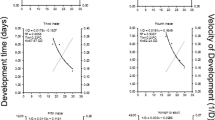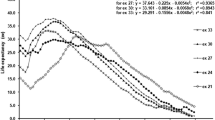Abstract
The effect of different constant temperatures (20, 25, 27, 30 and 35 °C) on life history stages of the Mexican chrysomelid beetle, Zygogramma bicolorata Pallister, fed on the weed Parthenium hysterophorus Linnaeus was investigated to analyse the development and survival of different life stages and the adult sex ratio. Fastest development and maximum survival were recorded at 27 °C. The first instar was the most vulnerable, while the pupa was least vulnerable. For complete development, the lower temperature threshold (t°C) was 18.5 °C and the thermal constant (K) was 480.8 day-degrees. A higher percentage of females was obtained at all temperatures; however, this was unaffected by the temperature regime. This study established that the percentage life span spent by immature stages was similar across all five temperatures, indicating developmental rate isomorphy. 27 °C was the most suitable temperature under controlled abiotic conditions for the propagation of Z. bicolorata, a bioagent for parthenium weed.
Similar content being viewed by others
References
Ali Khan M. A. and Yousuf M. (1986) Temperature and food requirements of Cheilomenes sexmaculata (Coleoptera: Coccinellidae). Environmental Entomology 15, 800–802.
Baumgärtner J., Bieri M. and Delucchi V. (1987) Growth and development of immature life stages of Propylea 14-punctata L. and Cocinella 7-punctata. (Coleoptera: Cocinellidae) simulated by the metabolic pool model. Entomophaga 32, 415–423.
Behrens K., Hoffmann K. H., Kempa S., Gäβler S. and Wallner G. M. (1983) Effect of diurnal thermoperiods and quickly oscillating temperatures on the development and reproduction of crickets Gryllus bimaculatus. Oecologia 59, 279–287.
Briere J. F. and Pracros P. (1998) Comparison of temperature dependent growth model with the development of Lobesia botrana (Lepidoptera: Tortricidae). Environmental Entomology 27, 94–101.
Dhileepan K., Setter S. D. and McFadyen R. E. (2000) Response of the weed Parthenium hysterophorus (Asteraceae) to defoliation by the introduced biocontrol agent, Zygogramma bicolorata (Coleoptera: Chrysomelidae). Biological Control 19, 9–16.
Dixon A. F. G. (2000) Insect Predator - Prey Dynamics: Ladybird Beetles and Biological Control. Cambridge University Press, Cambridge. 257 pp.
Frazer B. D. and McGregor R. R. (1992) Temperature-dependent survival and hatching rates of eggs of seven species of Coccinellidae. Canadian Entomologist 124, 305–312.
Henderson S. A. and Albrecht J. S. M. (1988) Abnormal and variable sex ratios in population samples of ladybirds. Biological Journal of the Linnaean Society 35, 275–296.
Honek A. and Kocourek F. (1988) Thermal requirements for development of aphidophagous Coccinellidae (Coleoptera) Chrysopidae, Hemerobiidae (Neuroptera), and Syrphidae (Diptera): Some general trends. Oecologia 76, 455–460.
Howe R. W. (1967) Temperature effects on embryonic development in insects. Annual Review of Entomology 10, 15–42.
Huffaker C., Berryman A. and Turchin P. (1999) Dynamics and regulation of insect populations, pp. 269–305. In Ecological Entomology, 2nd edn. (Edited by C. Huffaker and A. P. Gutierrez). Wiley, New York.
Ivanovic J. and Nenadovic V. (1999) The effect of diet and temperature on the life cycle of phytophagous insects. Pesticides 14, 309–327.
James B. E. (2001) Contribution on certain aspects of bioecology and behaviour of a ladybeetle, Coccinella transversalis Fabricus (Coccinellidae: Coleoptera). PhD thesis submitted to University of Lucknow, India. 190 pp.
Jarosik V., Honek A. and Dixon A. F. G. (2002) Developmental rate and isomorphy in insects and mites. The American Naturalist 160, 497–510.
Jayanth K. P. and Bali G. (1992) Estimation of number of generations of the Mexican beetle Zygogramma bicolorata Pallister (Coleoptera: Chrysomelidae) by measurement of thermal units. Journal of the Entomological Research Society 16, 273–276.
Jayanth K. P. and Bali G. (1993) Temperature tolerance of Zygogramma bicolorata (Coleoptera: Chrysomelidae) introduced for biological control of Parthenium hysterophorus (Asteraceae) in India. Journal of the Entomological Research Society 17, 27–34.
Langer A., Boivin G. and Hance T. (2004) Oviposition, flight and walking capacity at low temperatures of four aphid parasitoid species (Hymenoptera: Aphidiinae). European Journal of Entomology 101, 473–479.
Levesque K. R., Fortin M. and Mauffette Y. (2002) Temperature and food quality effects on growth, consumption and post-ingestive utilization efficiencies of the forest tent caterpillar Malacosoma disstria (Lepidoptera: Lasiocampidae). Bulletin ofEntomological Research 92, 127–136.
Minitab (2003) Minitab 13.1. Minitab Inc., State College, Pennsylvania, USA.
Morris R. F. and Fulton W. C. (1970) Models for the development and survival of Hyphantria cunea in relation to temperature and humidity. Memoirs of the Entomological Society of Canada 70, 1–60.
Obrycki J. J. and Tauber M. J. (1982) Thermal requirement for the development of Hippodamia convergens (Coleoptera: Coccinellidae). Annals of the Entomogical Society of America 75, 678–683.
Omkar and James B. E. (2004) Influence of temperature on the survival, development of immature stages and reproduction of a ladybeetle, Coccinella transversalis Fabricius. Entomon 29, 1–11.
Omkar and Pervez A. (2002) Influence of temperature on age specific fecundity of a ladybeetle, Propylea dissecta (Mulsant). Insect Science and Its Application 22, 61–65.
Omkar and Pervez A. (2004) Temperature-dependent development and immature survival of an aphidophagous ladybeetle, Propylea dissecta (Mulsant). Journal of Applied Entomology 128, 510–514.
Orr C. J. and Obrycki J. J. (1990) Thermal and dietary requirements for development of Hippodamia parenthesis (Coleoptera: Coccinellidae). Environmental Entomology 19, 1523–1527.
Ponsonby D. J. and Copland M. J. W. (1996) Effect of temperature on development and immature survival in the scale insect predator, Chilocorus nigritus (F.) (Coleoptera: Coccinellidae). Biocontrol Science and Technology 6, 101–109.
Ponsonby D. J. and Copland M. J. W. (1998) Environmental influences on fecundity, egg viability and egg cannibalism in the scale insect predator, Chilocorus nigritus. BioControl 43, 39–52.
Rodriguez-Saona C. and Miller J. C. (1999) Temperature-dependent effects on development, mortality, and growth of Hippodamia convergens (Coleoptera: Coccinellidae). Environmental Entomology 28, 518–522.
Rott A. S. and Ponsonby D. J. (2000) The effect of temperature, relative humidity and host plant on the behaviour of Stethorus punctillum as a predator of the two spotted spider mite, Tetranychus urticae. BioControl 45, 155–164.
Roy M., Brodeur J. and Cloutier C. (2002) Relationship between temperature and developmental rate of Stethorus punctillum (Coleoptera: Coccinellidae) and its prey Tetranychus mcdanieli (Acarina: Tetranychidae). Environmental Entomology 31, 177–187.
Srivastava S. and Omkar (2003) Influence of temperature on certain biological attributes of a ladybeetle, Coccinella septumpunctata Linnaeus. Entomologia Sinica 10, 185–193.
Withers T. M. (1998) Influence of plant species on host acceptance behaviour of the biocontrol agent Zygogramma bicolorata (Coleoptera: Chrysomelidae). Biological Control 13, 55–62.
Author information
Authors and Affiliations
Corresponding author
Rights and permissions
About this article
Cite this article
Omkar, Rastogi, S. & Pandey, P. Effect of temperature on development and immature survival of Zygogramma bicolorata (Coleoptera: Chrysomelidae) under laboratory conditions. Int J Trop Insect Sci 28, 130–135 (2008). https://doi.org/10.1017/S1742758408091728
Accepted:
Published:
Issue Date:
DOI: https://doi.org/10.1017/S1742758408091728




